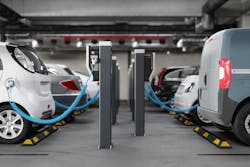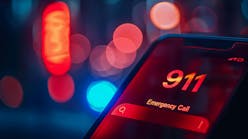Changes to the National Electrical Code Will Enhance the Safety of Firefighters and the Public
Back in 2023, members of the Big City Fire Working Group (BCF), which is organized under S&T’s First Responder Resource Group (FRRG), raised the need to modify National Fire Protection Association (NFPA) 70 (the National Electric Code) to add requirements for emergency disconnects on EV charging stations. This emergency disconnect requirement is similar to that required by another standard, NFPA 30A, at fuel dispensing facilities to stop the flow of fuel in an emergency. Responders who must operate at EV direct current (DC) fast-charging stations do so in an electrical energy environment ranging from 400 to 800 volts. Many responders are neither trained nor equipped to operate in extreme electrical hazard areas absent a readily accessible electrical disconnect.
Charging stations supplying DC power to EVs are primarily available along major highways and are becoming more available in public parking garages and workplace parking lots. When an emergency occurs at one of these EV charging stations, responders need a quick means to disconnect power to mitigate the emergency safely.
“The revision to NFPA 70 requiring the installation of emergency shut off devices at EV charging locations will aid in keeping our responders safe in these high energy environments,” says Captain Chris Greene of the Seattle Fire Department (retired).
The BCF includes senior fire service leaders from some of the largest fire departments in the United States, as measured by number of stations and operational personnel. Current participants represent Atlanta, Chicago, Dallas, Denver, Las Vegas, Los Angeles (city and county), Miami, New York City, Philadelphia, St. Louis, and Seattle. Members understand the highest priorities of their departments and collaborate with S&T and NUSTL to identify and discuss the needs and challenges of fighting fire in dense urban settings. They work together to identify gaps like this one, give input on enhancements to technology products or features, and inform publications, such as white papers, guides, standards, and requirements documents.
A task group comprised of BCF and NUSTL experts representing the U.S. fire service and members of the National Electrical Manufacturers Association (NEMA) representing industry was formed to recommend language to address the need and propose changes to the code—specifically to Article 625.
“The proposed requirements from the fire service were fairly simple. They requested an emergency disconnect that is easily seen, labeled appropriately, readily accessible, and operable without the use of specialized tooling. Matching the distance requirements for fueling stations, they asked to specify a 20-ft minimum distance from the EV supply equipment to the disconnect as a safety gap in case of an EV fire and a 100-ft maximum distance to ensure that the disconnect can be seen from the EV supply equipment,” said NUSTL BCF program manager Casandra Robinson. “Industry representatives helped to write the requirements so they are applicable for any EV charging station configuration and expanded the labeling requirement to make it clear that the emergency disconnect only deenergizes the EV supply equipment and that the EV is still energized.”
The group was led by David Kendall, ABB Electrification Director of Industry Affairs, who represents NEMA on NFPA 70, Code Making Panel-12 (the panel responsible for the section of the Code being modified). Kendall pulled in technical experts from NEMA to ensure that the proposed changes were written in a way that would meet the needs of all stakeholders.
“The task group consisting of BCF, NUSTL, and NEMA members demonstrates the collaboration and strength of working together,” Kendall said. “The work of the task group and the drafted language for NFPA 70, Section 625.43(B) was supported by the National Electric Code Technical Committee and will assist in the safety of first responders addressing incidents associated with EV charging stations.”
Over approximately 14 months, the task group worked through the steps required by the NFPA process, in conjunction with Code Making Panel-12. On October 16, the panel approved the new language for NFPA 70, Section 625.43(B).
The final step, which will take place in June 2025, is a National Electric Code Technical Committee ballot to approve the language for inclusion in the 2026 version of NFPA 70. The recent approval by the panel is a victory for BCF, and subsequent approval by the NFPA Technical Committee will finalize the new language and enhance the safety of all U.S. firefighters, as well as the public.
“This safety gap was identified by our emergency responders and is being corrected through working with industry partners to revise the Code,” said Captain Greene. “Together, we are making things a little safer for today's responders and for posterity.”
Other responder areas of interest being reviewed by BCF over the next year include active threat integrated response, robotics and remote systems, technology acquisition support, emerging threats, and equipment standards. These efforts are expected to have long-term positive impacts on fire department operations and personnel safety.







